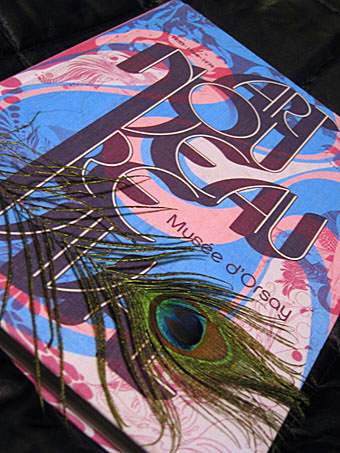
Catalogue for Art Nouveau Revival 1900 . 1933 . 1966 . 1974. Peacock feather not included.
Regular readers may recall my mention of the Musée d’Orsay exhibition Art Nouveau Revival which was launched late last year. I didn’t get to see the exhibition, unfortunately, but this week I finally ordered a copy of the catalogue, an expensive cloth-bound volume with essays (in French) by Philippe Thiébaut, Stephen Calloway, Irene de Guttry, Thierry Taittinger and Philippe Thieryre. Despite the ruinous postal charges incurred by the book’s weight this was worth every euro, it being the kind of polymorphous production which in solipsistic moments one can choose to believe was created solely for your own benefit.
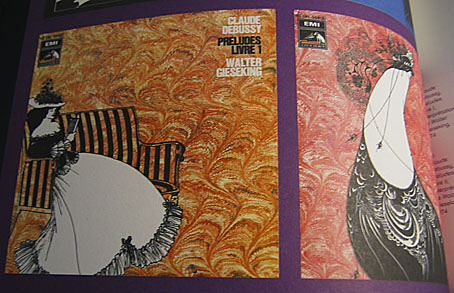
Aubrey again, album covers from 1974.
Much of the subject matter has been explored here in various small ways, with the curators following the influence of Art Nouveau through Surrealism (mainly Dalí) to the psychedelic art of the 1960s and on into the Pop Nouveau (for want of a better term) which flourished in the first half of the 1970s. Among the familiar Aubrey Beardsley graphics and psychedelic posters there are also some pleasantly surprising inclusions, including illustrations by Philippe Jullian (yes, I’m still intending on writing about him at some point), yet more Beardsley album covers, film posters, and even some of the sillier films of the late-60s such as Casino Royale. Being a French exhibition there’s a section devoted to comic strips which includes work by Moebius, Philippe Druillet and Guido Crepax.
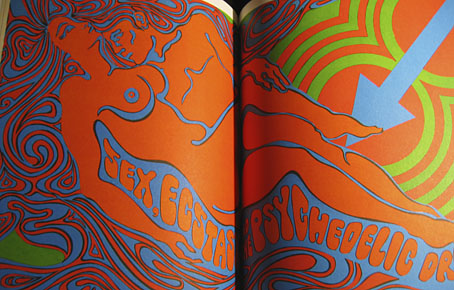
Sex and LSD, a spread from Playboy, 1967.
It’s common to see parallels drawn between the 1890s and the 1960s but the strange blooms of vulgarised fin de siècle style which burgeoned in the wake of psychedelia are seldom given much attention. One of the great things about this catalogue is the amount of ephemera the curators chose to include such as magazine ads and trend-chasing album sleeves. It was precisely this blend of 1890s + 1960s + 1970s I sought to capture in my recent cover for Dodgem Logic. As I said, it’s an expensive book but for anyone drawn to this aesthetic hothouse it’s also an essential purchase. Art Nouveau Revival can be ordered direct from the museum shop. Further samples follow.
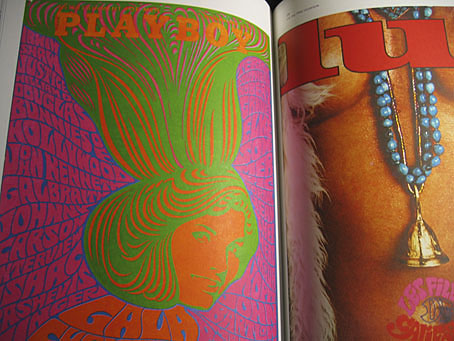
Playboy goes psychedelic, 1967.
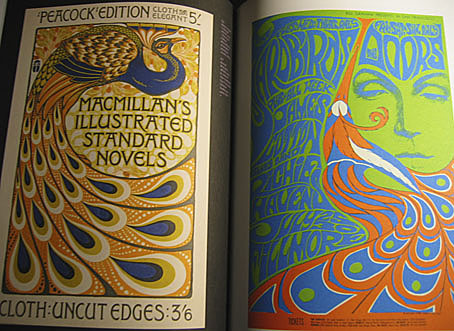
The ubiquitous peacock by Albert Angus Turbayne, 1903.
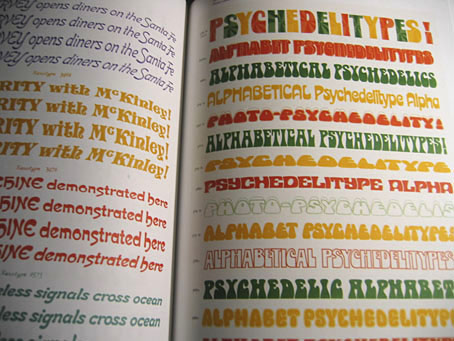
Assorted type designs.
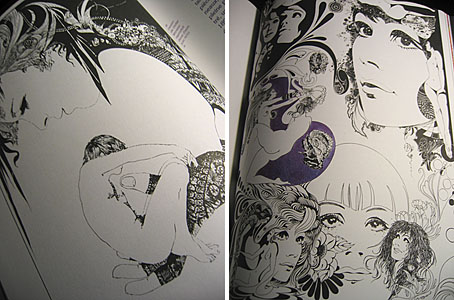
Some gorgeous b&w pieces by Didier Moreau (why isn’t there more of his work around?), 1970, and Nicolas Devil, 1967.
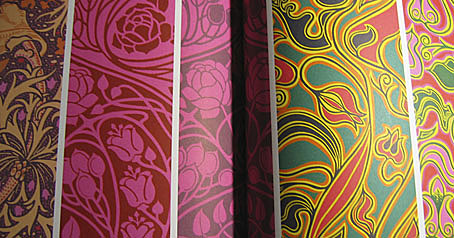
Assorted wallpaper designs.
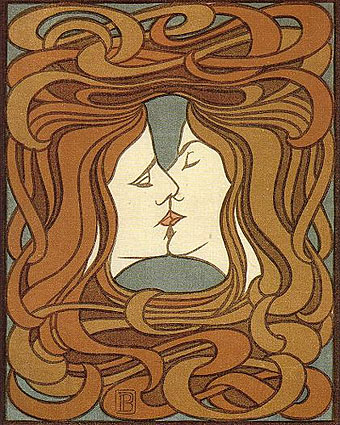
This ambiguous, possibly androgynous, Peter Behrens piece, The Kiss, from 1899 surprised me in light of the same-sex kiss I used for the Dodgem Logic cover.
Another pleasant inclusion, the fantastic poster design by David Palladini for Werner Herzog’s 1979 film. I have the quad version hanging over my desk in this room.
Previously on { feuilleton }
• Dodgem Logic again
• Dodgem Logic #4
• Art Nouveau Revival 1900 . 1933 . 1966 . 1974
• Beardsley at the V&A
• Aubrey Beardsley’s musical afterlife


What an amazing book, I’m coveting it even as you’re reading this.
Thank you, I will look into adding this to my library. A marvelous resource on a topic I am essentially ignorant of it. You state the similarities between the fin de siecle and the 60’s, but I am less aware of the similarity. I will need to explore this.
Thom: I was thinking of you, too! Verner Panton is present, among other designers, and you’d just posted some of his work again.
Hi Leonard. A number of the more recent books on psychedelic poster art draw parallels between the 60s artists and the earlier poster designers, showing how they borrowed motifs, type designs and so on. This book goes a lot further than that into the more commercial uses of these styles.
I see. I was curious as to what social similarities had caused the borrowing. perhaps it was just based on an affection for the graphics and their commercial application.
Thanks as always.
It’s mostly an affection for the graphics but also the whole of the 1960s saw a reappraisal by the baby-boomer generation of the culture from their grandparents’ time. The trends of the 1890s-1900s were swept away (and often vilified) by Modernism but after the conformity and drabness of the 1950s all that florid, exotic art began to look exciting again. There were major exhibitions of Beardsley’s work and Symbolist painting from the mid-60s onwards which stimulated a wider interest in the height of Victorian art, especially the Decadent work. The San Francisco poster artists were the first to start using Victorian aesthetics in their designs. Other people in London and elsewhere quickly followed suit.
I suspected something was afloat, so many of my volumes concerning Beardsley/Art Nouveau are from the 60’s. The love of the exuberant certainly makes sense as per post modernism. Again, thank , always a pleasure.
Leonard
My dad used to have a poster from Saga de Xam hanging on one of the doors in his office. I wonder what happened to it (possibly binned as it was getting tattered). I remember some old playboy magazines too, a few pages very psychedelic.
Isn’t it wonderful when a book seems a treasure rather than a letdown-as they sometimes do. Such an interesting ongoing conversation, and I can only think always of Beardsley prints- with Rod Stewart’s experience, so he seems to have been into printmaking at some point too. And wouldn’t Oscar have been wilde for the 70’s
Wilde would have been wild for Sylvester, i wish they could have met, what a marvelous moment that would have been.
After reading this post, i HAD to own this book. Amazingly, Amazon had a copy for £38 , considerably less than the museum shop (with postage). I guess it must be my lucky day.
I think the sixties/seventies connection with the 1890s went deeper than just aesthetics. Decadence, drugs mysticism occultism radical politics and sexuality were all brewing under the surface of both eras.
In mainstream culture, both eras were very conformist, the 1890s being perhaps the last gasp of the industrial age before world war one, the 60s being the flowering of the consumerist society we know and love today. Its not hard to see how nature worship, softness, dreams and beauty could be subversive.
Lord Plum presents an apt description of two magical moments in time, thanks.
Little Augury: Yes, I guessed this would be worthwhile on account of Stephen Calloway’s involvement. But the book itself is also beautifully designed and produced.
Lord Cornelius Plum: I’d been haunting Amazon (and Abe) for months hoping a copy might appear, so you’re very fortunate. As to the 1890s/1960s interface, the parallels have fascinated me for years. Both gay rights and feminism were in the air during the 90s (“Uranians” and the “New Woman” as the Victorians had it) and came to the fore again in the 60s, of course. The same goes for radical politics (Socialism, Anarchism) as well as other obvious signifiers such as drugs and occultism. And as I never tire of pointing out, Aubrey Beardsley and Oscar Wilde are on the cover of Sgt Pepper.
oh, those Uranians……………..